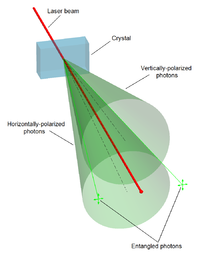
Photo from wikipedia
We study the optical properties of the $$\hbox {Ag}_{29}$$ (BDT) $$_{12}$$ (TPP) $$_4$$ cluster, the geometry of which is available from experimental structure determination, by means of Fourier-transformed induced densities… Click to show full abstract
We study the optical properties of the $$\hbox {Ag}_{29}$$ (BDT) $$_{12}$$ (TPP) $$_4$$ cluster, the geometry of which is available from experimental structure determination, by means of Fourier-transformed induced densities from real-time (time evolution) calculations of time-dependent density-functional theory. In particular, we demonstrate the influence of the ligands on the optical spectra in the visible region and, even more, in the UV. A strong peak in the UV reminiscent of the spectrum of isolated benzene is found to be caused by the phenyl rings of the TPP ligand molecules. Nonetheless, their absence in the modeling also impacts the absorption in the visible region substantially. By contrast, the aromatic rings of the BDT ligands are more strongly coupled to the silver core and loose the character of independent oscillators; they contribute a much less peaked UV absorption. Our results underline the importance of properly accounting for the full ligands for precise and reliable modeling.
Journal Title: Theoretical Chemistry Accounts
Year Published: 2021
Link to full text (if available)
Share on Social Media: Sign Up to like & get
recommendations!